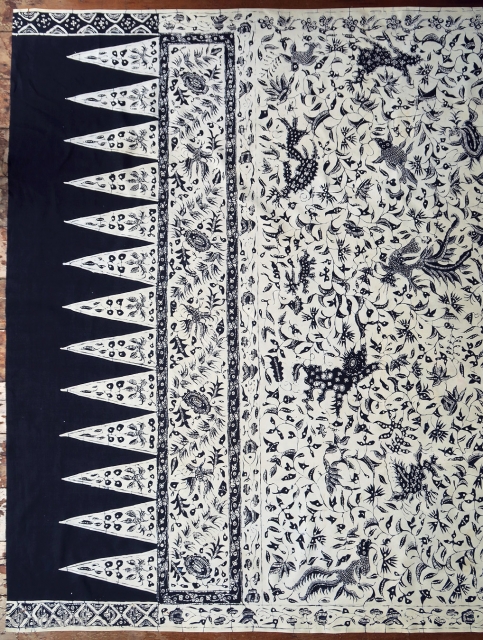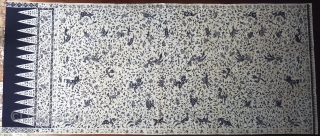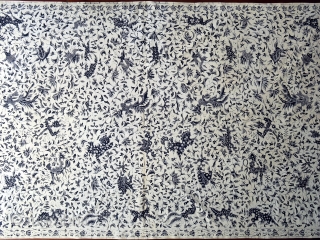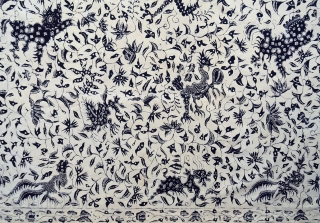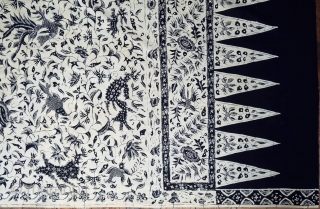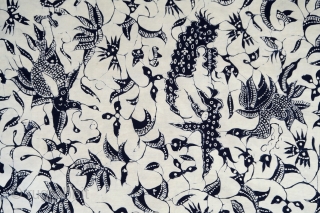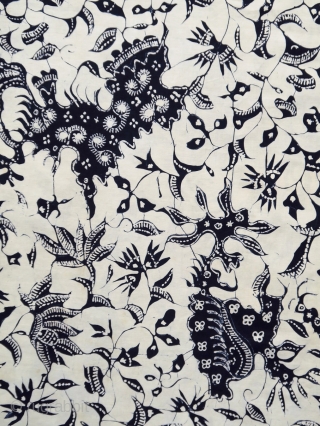Back
Javanese batik hipcloth (Kain Panjang)
Origin: Java, Cirebon, c. 1930
Technique: Commercial cotton, natural dyes, hand-drawn (tulis) batik
Description: a very charming blue and white batik hipcloth hand-drawn in the court town of Cirebon on the north coast of Java with a lively design of creatures amidst wandering flowering vines. a variation on the traditional central Javanese forest creatures (alas-alasan) pattern, the creatures span the 3 realms of water, earth and air, and are particularly notable for their fantastical styling—some are identifiable, such as birds, lobsters, fish, or giraffes, but quite a number leave a great deal to the imagination, and seem to be metamorphosing from the plant-life, or vice versa. They are decorated with a range of small motifs—crosses, circles, spirals, lines of dots—and depicted with expressive movement in a delicate curvilinear drawing style. This style emphasizes lines and spots of color against a clear ground, creating a feeling of spaciousness typical of Cirebon batik. The repetition of similar forms in the creatures incorporates much interesting variation in detail, giving the design the aliveness for which hand-drawn batik is prized by the Javanese.
The blossoms of the vine include the carnation (celuki), the quintessential north coast batik flower. The end that would be displayed when the hipcloth was worn has a dramatic border of triangles marked off from the centerfield by a panel with fruits and the mythical bird lokcan, which derives from the phoenix.
Context: The only court city on the north coast of Java, Cirebon was much more eclectic and multi-cultural than the traditional courts of central Java (Solo and Jogjakarta), embracing the mixture of cultures that grew around the commerce of the Spice Islands trade route in the 19th c. The design of this batik shows an interesting mixture of elements: The vine wandering over the cloth in a free-flowing multi-directional movement is a traditional north coast batik format called lung-lungan (creeper tendril), and its flowers evoke the scattering of blossoms in rituals. The fantastical creatures metamorphosing into or out of plant life are a very old design from the Cirebon / Indramayu area. However, their regular placement and more distinct forms show the influence of the central Javanese alas-alasan pattern. Batik with blue and white designs were a type called kelengan, worn during mourning by Peranakan Chinese, but also traditional in Java and Sumatra. The border of triangles suggests that it was made for export to the large batik market of Chinese clients in Sumatra, where this format was popular.
Condition: The hipcloth is in excellent condition, There are 2 small 1.5 cm tears at the edge of 2 different corners—apart from these there are no holes, stains, or tears. The design is in a deep blue-black shade, and the ground is beige. The cotton is very smooth, supple and soft, and fairly heavy.
Dimensions: Length: 250 cm. Width: 105 cm.
Origin: Java, Cirebon, c. 1930
Technique: Commercial cotton, natural dyes, hand-drawn (tulis) batik
Description: a very charming blue and white batik hipcloth hand-drawn in the court town of Cirebon on the north coast of Java with a lively design of creatures amidst wandering flowering vines. a variation on the traditional central Javanese forest creatures (alas-alasan) pattern, the creatures span the 3 realms of water, earth and air, and are particularly notable for their fantastical styling—some are identifiable, such as birds, lobsters, fish, or giraffes, but quite a number leave a great deal to the imagination, and seem to be metamorphosing from the plant-life, or vice versa. They are decorated with a range of small motifs—crosses, circles, spirals, lines of dots—and depicted with expressive movement in a delicate curvilinear drawing style. This style emphasizes lines and spots of color against a clear ground, creating a feeling of spaciousness typical of Cirebon batik. The repetition of similar forms in the creatures incorporates much interesting variation in detail, giving the design the aliveness for which hand-drawn batik is prized by the Javanese.
The blossoms of the vine include the carnation (celuki), the quintessential north coast batik flower. The end that would be displayed when the hipcloth was worn has a dramatic border of triangles marked off from the centerfield by a panel with fruits and the mythical bird lokcan, which derives from the phoenix.
Context: The only court city on the north coast of Java, Cirebon was much more eclectic and multi-cultural than the traditional courts of central Java (Solo and Jogjakarta), embracing the mixture of cultures that grew around the commerce of the Spice Islands trade route in the 19th c. The design of this batik shows an interesting mixture of elements: The vine wandering over the cloth in a free-flowing multi-directional movement is a traditional north coast batik format called lung-lungan (creeper tendril), and its flowers evoke the scattering of blossoms in rituals. The fantastical creatures metamorphosing into or out of plant life are a very old design from the Cirebon / Indramayu area. However, their regular placement and more distinct forms show the influence of the central Javanese alas-alasan pattern. Batik with blue and white designs were a type called kelengan, worn during mourning by Peranakan Chinese, but also traditional in Java and Sumatra. The border of triangles suggests that it was made for export to the large batik market of Chinese clients in Sumatra, where this format was popular.
Condition: The hipcloth is in excellent condition, There are 2 small 1.5 cm tears at the edge of 2 different corners—apart from these there are no holes, stains, or tears. The design is in a deep blue-black shade, and the ground is beige. The cotton is very smooth, supple and soft, and fairly heavy.
Dimensions: Length: 250 cm. Width: 105 cm.
price:
On request
- Home
- Antique Rugs by Region
- Category
- Profiles
- Post Items Free
- Albums
- Benaki Museum of Islamic Art
- Budapest: Ottoman Carpets
- Gulbenkian Museum
- Islamic Carpets. Brooklyn
- Islamic Textiles. Brooklyn
- Konya Museum: Rugs
- MKG, Hamburg
- MMA: Caucasian Carpets
- MMA: Mamluk Carpets
- MMA: Mughal Indian Carpets
- MMA: Ottoman Carpets
- MMA: Safavid Persian Carpets
- MMA: Turkmen Rugs
- McCoy Jones Kilims
- Ottoman textiles. Met
- Philadelphia Museum
- Rugs and Carpets: Berlin
- Seljuqs at the Met
- TIEM, Istanbul: Carpets
- V&A: Classical Carpets
- Vakiflar Carpets: Istanbul
- Baluch Rugs: Indianapolis
- Gallery Exhibitions
- Jaf an Exhibition
- Alberto Levi Gallery
- Andean Textile
- Christie's London: 2016
- Francesca Galloway
- HALI at 40
- ICOC Washington, DC 2018
- Jajims of the Shahsavan
- London Islamic Week April, 2018
- Mongolian Felts
- Navajo Rugs: JB Moore
- Persian Piled Weavings
- SF Tribal & Textile Art Show 2020
- SF Tribal 2019
- Sotheby's: C. Alexander
- Turkish Prayer Rugs
- Turkmen Main Carpets ICOC 2007







